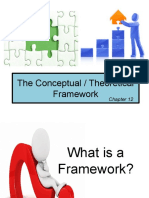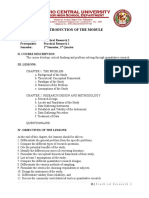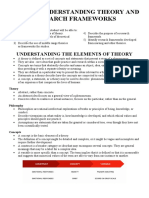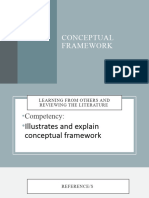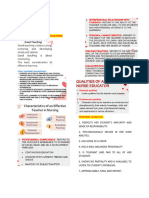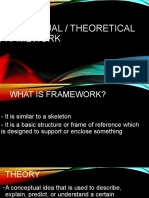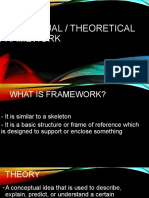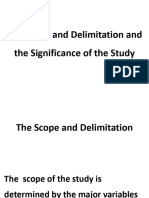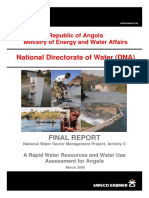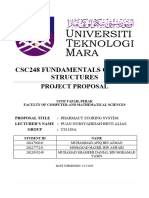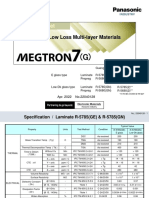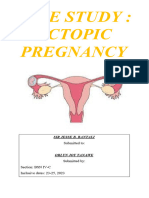Practical Research 2: Module 3 - Learning from
others and Reviewing the Literature
INTRODUCTION
This module in Practical Research 2 provides the chance to discover and learn
new things. It illustrates and explain the conceptual framework, the definition of terms
conceptually and operationally and learning the research hypothesis. It presents also
the written review of related literature and conceptual framework.
This module has three (3) parts or lessons. Lesson one (1) illustrations and
explanation of conceptual framework; Lesson two (2) deals about definition of terms
and list of research hypothesis; Lesson three (3) is about the Review of Related
Literature.
Every part of the module contains different activities and enhancement
exercises utilizing pictures, and illustrations which have been proven as effective
instructional materials in improving the research skills of the students.
LESSON 1
LEARNING CONTENT
The Formulation of Conceptual Framework
(Week 10)
LEARNING ACTIVITY
A. Presentation
Why is theoretical and conceptual framework important in making Quantitative
Research?
1
� B. Discussion
Theoretical Framework
The theoretical framework which may be formulated from an existing
theory/ies serves as the foundation of the study. In such case, the paradigm that is
originally used by the theorist can be fully adopted in the present study. It can also
be adapted since the researcher can add or subtract variables from the original
framework provided that the whole theory is utilized.
In the formulation of a theoretical framework, relevant theories must be
provided. The researcher cites and discusses related theories that serve as the
foundation of the variables and their relationships to make the study more scientific
and understandable especially to the readers. The researcher mention theories,
including the names of the authors, titles of their theories, theoretical principles, and
their explanation. When this requirement has been satisfied, the concluding portion
is the relationship of the used, established theory to the present study.
Conceptual Framework
It is a largely based on theories or part of the theory combined with other parts
of another theory, or on the intellectual synthesis of the various readings of the
researcher. It guides the researcher by giving clear directions to the research.
Paradigm of the Study
The result of a clear understanding of the conceptual or theoretical framework
is a diagrammatic presentation of the study called the Paradigm.
Merriam-Webster (2006) defines paradigm as a pattern, model, or set of
forms which contains particular elements. It is the researcher’s scientific imagination
expressed graphically by drawings or sketches. In a scientific work, the symbols
must be specific in meaning. The usual figures used are regular shapes, lines, and
arrows. Irregular shapes are sometimes utilized and there must be an acceptable
rationale for them. The paradigm is something like a visual representation of the
entire thesis. It is considered as the heart of the research paper. A title is needed to
encapsulate the whole paradigm.
The Common Paradigms or Models used as follows:
1. IPO Model (Input-Process-Output)
This model is largely used when the research attempts to isolate the
factor or major variables that causes the problem, subject, or
phenomenon under investigation. This model is used when the
statements of the problem are all factor-isolating questions.
Example:
>Profile of Entrepreneurs Analysis of data Profile and roles
a. age through the of entrepreneurs
2
� b. sex questionnaire, are determined
c. seminars attended informal interviews
>Roles of Entrepreneurs and statistical
a. Assessment treatment
b. Planning
c. Implementation
d. Evaluation
Figure 1. Sample of IPO Model Entrepreneurs’ Roles Toward Improve Work
Performance
2. IV-DV Model (Independent Variable-Dependent Variable Model)
This model is used in experiment-based studies. The questions raised
are higher order and classified as situation-relating.
Example:
Teaching methodology used Level of performance of Grade
by instructors 12 students
Computer-assisted Academic Grades
instruction Practicum grades
Demonstration Parent’s satisfaction
method
Figure 2: Sample IV-DV Model for the Effects of Computer-assisted instruction
and Demonstration Method on the Level of Performance of Grade 12 Students
3. PC Model (predictor-criterion model)
This model is used when relating and assessing the influence between
two or more variables. Studies that focus on relationships, associations,
differences, and impacts will benefit from this model.
Example:
Teaching competence of Level of performance of ABM
senior high school teachers students
Knowledge level Academic grades
Pedagogical skills Behavioral attributes
Classroom Peer evaluation result
management
Figure 3: Sample PC Model for the Relationship of the Teaching Competence
of Senior High School Teachers to the Level of Performance of ABM Students
3
� 4. -P Model - This model is used in research studies that propose a program or
any intervention measure. It fits the situation producing level of questioning.
Example:
Teaching Competence Level of
Of Instructors Performance of
Students P Faculty
>Knowledge Level >Academic grades Development
>Pedagogical Skills >Practicum Program
>Classroom Mgt. Performance
Figure 4: Sample -P Model for Teaching Competence of Instructors and the Level of
Performance of Students Towards the Formulation of the Faculty Development
Program
5. POM (Proposed Original Model). This model is used when the researcher
presents an original paradigm. The requirement is that it must be scientific.
Example:
>Infection control >Extent of
Participation
Practices in the infection
>Preparation of IV > Control Program
Student Respondent’s fluids > CI’s Assessment
Profile >Preparation of IV of the students’
extent
Medication of participation in
Age >Assistance in the infection control
Gender administration of IV practices.
Civil status medications
Hospital >Skin Care
Assignment >Umbilical Cord Care
>Eye Care
Enhanced Related Leaning Experience Supervisory Program
Figure 5. Sample POM for the extent of participation of the nursing students in
infection Control Practices: Basis for enhanced RLE Supervisor Program:
4
� LESSON 2
LEARNING CONTENT
The Research Hypothesis and Assumption of the Study
(Week 11)
LEARNING ACTIVITY
A. Presentation
Why is there a need to have a hypothesis of the study in Quantitative Research?
B. Discussion
The Hypothesis and Assumptions of the Study
Hypothesis of the Study
A hypothesis is a tentative prediction about the relationship between two or
more variables in a population under study (Polit, 2007). It translates a research
question into a prediction of expected outcomes. It is commonly used in an
experiment-type research, formulated particularly before the conduct of an
experimental-quantitative research. It is also considered an intelligent guess that
occurs with at least 2 variables: one is independent and the other is dependent. it is
only after the experimentation that the researcher can finally assess if his/ her guess
is correct or not. When the result of the experiment is the same as the hypothesis,
then the hypothesis is accepted. When the result of the study is the exact opposite of
the hypothesis, then the hypothesis is rejected.
Kinds of Hypothesis
1. Simple Hypothesis
It is a hypothesis formulated when predicting a relationship between an
independent variable and a dependent variable.
Examples.:
a. The nature of teachers is related to the nature of the students
b. There is a relationship between the level of exercise weight retention
among elementary school children.
2. Complex Hypothesis
It is a hypothesis formulated when predicting the relationships of two or
more independent variables to two or more dependent variables.
5
� Examples:
a. There is no significant relationship between the profile, classroom
leadership, and management skills and the school’s performance of
Sunday school teachers.
b. The intrapersonal and interpersonal competencies of principals do not
relate significant to the performance of secondary schools.
3. Directional Hypothesis
It is a hypothesis that specifies not only the existence but also the
expected direction of the relationship between the independent and
dependent variables.
Examples.
a. Lower levels of exercise are associated with greater weight retention
than higher levels of exercise.
b. The types of promotional campaigns positively affect the level of
patronage of customers.
4. Non-Directional Hypothesis
It is a hypothesis that does not stipulate the direction of the relationship
between the independent and dependent variables.
Examples:
a. Women with different levels of postpartum depression differ with
regard to weight retention.
b. The sources of stress are related to the different coping mechanisms
among teachers.
5. Null Hypothesis
It is a hypothesis formulated for the purpose of statistical analysis. The
kind is always expressed as a negative statement. It is subjected to testing
in which the decision is either to accept or reject it.
Examples:
a. There is no significant relationship between the reasons for using
alternative medicine and the level of comfort of the patients.
b. The kind of teaching methods used has no effect on the level of
performance od students as shown in their academic grades and
behavior in class.
6. Research Hypothesis
6
� It is a hypothesis which states the actual expected relationships between
variables. It is always expressed affirmatively and is called substantive or
scientific hypotheses.
All examples of hypotheses mentioned above can be categorized as such if
they express the expected relationships of variables.
Assumptions of the Study
The study or research assumptions are propositions taken to be true based
upon the presupposition without preponderance of the facts. These proposition often
refer to the different variables or sub-variables being studied.
Example:
Research Title: The Relationship Between the Psychosocial Health Effects of Stress
and the Coping Mechanisms of Nursing Mothers (Ancero,et al., 2010)
The following assumptions are enumerated by the researchers.
1. Disorders can be acquired from abnormal stress response.
2. Different source of stress can be managed through a healthy way of response.
3. Managing stress with exercise can prevent negative physical and mental health
effects.
4. There are techniques and strategies to follow in order to be successful in
coping.
5. Psychological health effects of stress can be prevented by effective coping
mechanisms of nursing student mothers.
Lesson 3
LEARNING CONTENT
Definition of Terms
(Week 12)
LEARNING ACTIVITY
A. PRESENTATION
What words are usually defined in the definition of terms?
7
� B. DISCUSSION
Definition of Terms
The important terms used in the study must be defined clearly. Some of these
terms appear in the thesis title, statement of the problem, theoretical paradigm, and in
the scope and delimitation of the study. Certain terms may refer to the respondents,
subjects and the variables and sub-variables. Defining the different terms may be done
conceptually or operationally. When a term is defined using books and dictionaries
then it is defined conceptually. On the other hand, when the definition of the term is
based on how it is used in the study, it is defined operationally. A combination of the
two methods is often helpful.
Terms that are defined must be arranged alphabetically. Moreover, before
defining the enumerated or listed terms there must be an opening sentence or an
introductory paragraph.
Examples:
a. Terms that are defined conceptually.
Drugs.
These may refer to a substance or mixture of substances used in
diagnosis, treatment, and prevention of disease or for the modification
of physiological function or prevention of pregnancy and which is
incorporate in an official list (Chaudhurri,2003)
Ethics.
A branch of philosophy that addresses questions of right or
wrong. It is a term that refers to the various ways of understanding and
examining moral life (Mappes, 2002).
b. Terms that are defined operationally:
Leadership attributes
These pertain to the rating of deans in a questionnaire as to what
they consider to be the most important attribute or function of their position:
personal integrity, willingness to accept responsibility, understanding
people, communication, selflessness, intuitions, vision, decision-making
ability, or ability to simplify situations.
Leadership styles
These refer to the styles of management practiced by the deans,
which may be autocratic or participative and measured by Likert scales.
Study habits
8
� As used in this research, these pertain to the routinary study
methods utilized by students like memorization, use of the Internet, going to
the library, and peer review.
c. Terms that are defined conceptually and operationally:
Eating disorders
A group of behaviors fueled by unresolved emotional conflicts, resulting
in altered food consumption (Grpdner,2005). As used in this study, it
pertains to the kind of food, frequency of eating, and amount of intake or
consumption.
Personality
It refers to the sum total of the qualities and characteristics of a person
as shown in his/her manners such as walking, talking, dressing, acting,
attitudes, interest, and ways of reacting to other people, which are
manifestations of his/her behavior thoughts, and emotions


